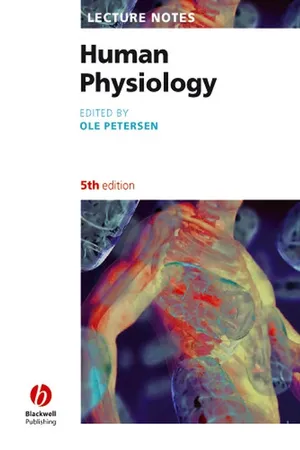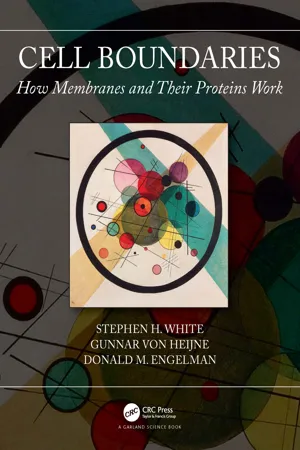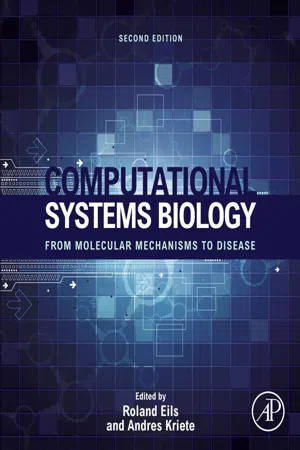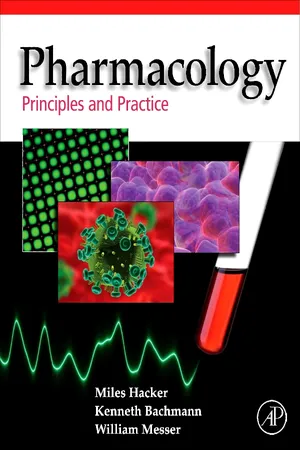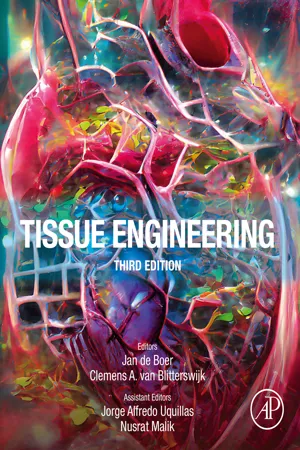Biological Sciences
Signal Reception
Signal reception refers to the process by which cells detect and respond to external signals, such as hormones or neurotransmitters. This typically involves the binding of the signaling molecule to a specific receptor on the cell surface, triggering a series of intracellular events that ultimately lead to a cellular response. Signal reception is a crucial aspect of cell communication and coordination within biological systems.
Written by Perlego with AI-assistance
Related key terms
Related key terms
1 of 4
Related key terms
1 of 3
6 Key excerpts on "Signal Reception"
- eBook - ePub
Lecture Notes
Human Physiology
- Ole H. Petersen(Author)
- 2019(Publication Date)
- Wiley-Blackwell(Publisher)
Chapter 2 Cellular CommunicationCells communicate with one another by chemical and electrical signals. There are also specialized sensory cells that respond to chemical, electrical, light, mechanical or heat stimuli that may come from external or internal sources. The cellular response to these signals may be simple and short-lived, such as depolarization, or it may be complex and long-lasting, such as the acquisition of memory. Nevertheless, the cellular mechanisms underlying these responses have much in common. Each of these signals is transduced into electrical or biochemical changes within the cell, which lead to a characteristic response. For example, the stimuli that give rise to the sensations of taste, smell, hearing and vision, and also certain neurotransmitters and hormones, can all control the opening and closing of ion channels and depolarize or hyperpolarize cells.In this chapter we discuss how information is transmitted between cells, and how signals from the external and internal environment are received and transduced into electrical and biochemical changes within the cell.2.1 How signals are transmitted between cells
Cells communicate with one another by chemical signals that either diffuse between cells (neurotransmitters, and paracrine and autocrine agents), or are disseminated in the blood (hormones). These signals include small organic molecules (e.g. acetylcholine and adrenaline), and larger molecules such as proteins and steroids. Cells may also communicate with their immediate neighbours through gap junctions, which transmit both electrical and chemical signals. - eBook - ePub
- Thomas E Schlaepfer, Charles B. Nemeroff(Authors)
- 2012(Publication Date)
- Elsevier(Publisher)
Handbook of Clinical Neurology , Vol. 106, No. Suppl (C), 2012ISSN: 0072-9752doi: 10.1016/B978-0-444-52002-9.00002-4Chapter 2 Receptor signaling and the cell biology of synaptic transmissionJiang-Zhou Yu, Mark M. Rasenick* E-mail address: [email protected],Departments of Physiology and Biophysics and Psychiatry, University of Illinois Chicago College of Medicine, Chicago, IL, USA* Correspondence to: Mark M. Rasenick, Distinguished UIC Professor of Physiology and Biophysics and Psychiatry, Director, Biomedical Neuroscience Training Program, University of Illinois Chicago College of Medicine, 835 S. Wolcott m/c 901, Chicago, IL 60612-7342, USA. Tel: 312 996 6641, Fax: 312 996 1414,AbstractThis volume describes a series of psychiatric and neuropsychiatric disorders, connects some aspects of somatic and psychiatric medicine, and describes various current and emerging therapies. The purpose of this chapter is to set the stage for the volume by developing the theoretical basis of synaptic transmission and introducing the various neurotransmitters and their receptors involved in the process. The intent is to provide not only a historical context through which to understand neurotransmitters, but a current contextual basis for understanding neuronal signal transduction and applying this knowledge to facilitate treatment of maladies of the brain and mind.Introduction
Receptors are proteins (either at the cell surface or intracellular) that bind hormone/neurotransmitters and begin the process of converting the agonist from extracellular signal to intracellular response. Generally, receptors recognize a particular hormone/neurotransmitter with great specificity and high affinity. Subsequent to the binding of their agonists, these receptors undergo a change of conformation which shifts them into an activated state. - eBook - ePub
Cell Boundaries
How Membranes and Their Proteins Work
- Stephen White, Gunnar von Heijne, Donald Engelman(Authors)
- 2021(Publication Date)
- Garland Science(Publisher)
15 Information Transfer: Signaling in Cells DOI: 10.1201/9780429341328-16 All cells in an organism have the same genome, yet they develop into different organs and become specialized for different functions during development. Even single-cell organisms must be able to react to changes in their environment. How can cells react to what goes on in their surroundings? How are they triggered by extracellular or intracellular signaling molecules to activate intracellular regulatory circuits that move them down specific developmental pathways or guide their migration? In short, how can information be transferred from the outside of the cell to its inside? In both single-cell and multicellular organisms, information transfer in most cases involves transmembrane (TM) receptors located at the cell surface (Figure 15.1). The classical view is that binding of an extracellular ligand traps the receptor in an “active” state—a conformation that allows intracellular effector proteins to bind to cytosolic parts of the receptor and to be activated in turn. The activated effector proteins then diffuse into the cell, triggering cellular responses such as the opening of ion channels or activation of gene transcription. Certain small signaling molecules do not need receptors on the cell surface but can diffuse across the cell membrane into the cell and trigger soluble nuclear receptors that bind directly to DNA. Still other signals arise from the cytoplasm and interact directly with cytoplasmic domains of kinases. Figure 15.1 A few of the signal transduction pathways in eukaryotes. The pathways are numerous and complex, and interact with one another - eBook - ePub
Computational Systems Biology
From Molecular Mechanisms to Disease
- Andres Kriete, Roland Eils(Authors)
- 2013(Publication Date)
- Academic Press(Publisher)
Chapter 4Biological Foundations of Signal Transduction, Systems Biology and Aberrations in Disease
Ursula Klingmüller, Marcel Schilling, Sofia Depner and Lorenza A. D’Alessandro, Division Systems Biology of Signal Transduction, German Cancer Research Center (DKFZ), Heidelberg, Germany ,E-mail: [email protected]Abstract
Cellular communication is mediated by extracellular stimuli that bind cellular receptors and activate intracellular signaling pathways. Principal biochemical reactions used for signal transduction are protein or lipid phosphorylation, proteolytic cleavage, protein degradation and complex formation mediated by protein-protein interactions. Within the nucleus, signaling pathways regulate transcription factor activity and gene expression. Cells differ in their competence to respond to extracellular stimuli. A deeper understanding of complex biological responses cannot be achieved by traditional approaches but requires the combination of experimental data with mathematical modeling. Following a systems biology approach, data-based mathematical models describing sub-modules of signaling pathways have been established. By combining computer simulations with experimental verification systems properties of signaling pathway including cycling behavior or threshold response could be identified. Yet, to analyze complex growth and maturation processes at a systems level and quantitatively predict the outcome of perturbations further advances in experimental and theoretical methodologies are required.Keywords
Signaling; Protein; Modeling; Dynamic; Parameter; Multiplex analysis1 Introduction
Cells do not live in isolation, but have evolved mechanisms to communicate. Principal signals used are direct cell-cell contact and secreted molecules that bind to cell surface receptors. Arrays of intracellular proteins form signal transduction pathways and connect to receptors. This facilitates signal transmission from the extracellular compartment to the nucleus and thereby triggering various biological responses. A key mechanism used for signal transduction is phosphorylation due to its simplicity, flexibility, and reversibility. In the late 1970s it was discovered that the oncogene v-Src can transform cells, possesses protein kinase activity and causes an increase in tyrosine phosphorylation (Hunter and Sefton 1980 - eBook - ePub
Pharmacology
Principles and Practice
- Miles Hacker, William S. Messer, Kenneth A. Bachmann(Authors)
- 2009(Publication Date)
- Academic Press(Publisher)
Chapter 6. Signal Transduction and Second MessengersKaren Lounsbury
Outline6.1 Receptor Communication 1036.1.1 Ion Channels 1036.1.2 G-Protein Coupled Receptors 1036.1.3 Receptor Tyrosine Kinases 1076.1.4 Cytokine Receptors (Tyrosine Kinase-Associated Receptors) 1096.1.5 Intracellular Receptors 1096.1.6 Other Classes of Receptors 1106.2 Receptor/Second Messenger Crosstalk 1106.3 Signal Transduction Targets for Drug Discovery 111Central to the communication between cells is the process of signal transduction. Signal transduction is the mechanism by which cell surface receptors receive information from extracellular signals such as hormones and neurotransmitters, and amplify this information through the actions of second messengers. Second messengers in turn activate pathways intrinsic to processes such as protein secretion, cell differentiation, and cell division. Many pharmacological agents elicit their clinical activity and side effects through interactions with receptors and/or their downstream signaling targets. As our understanding of receptor signaling has progressed, intracellular signaling molecules have become a major target of drug discovery. This chapter will review the major receptor-mediated signaling pathways and will outline current and future therapeutic strategies to target these pathways.6.1. Receptor CommunicationReceptors are the primary sensors of the cell environment, but ligand binding alone is useless without signal transduction. The effect of a pharmacologic agent on the ability of receptors to couple to downstream signals thus defines whether it will increase (agonist) or decrease (antagonist) the physiologic activity of the receptor. Selective regulation of the magnitude, time-course, and spread of the signal allows a single ligand to transmit a complex set of physiological effects. Signal transduction by receptors can be broken into four major categories:▪ Ion channels ▪ G protein-coupled receptors ▪ Receptor tyrosine kinases ▪ Intracellular receptors - eBook - ePub
- Clemens van Blitterswijk, Jan De Boer(Authors)
- 2022(Publication Date)
- Academic Press(Publisher)
Chapter 4: Cellular signaling
Vanessa LaPointe1, and Kristopher A. Kilian2,3,41 MERLN Institute for Technology-Inspired Regenerative Medicine, Maastricht University, Maastricht, The Netherlands2 School of Materials Science and Engineering, University of New South Wales, Sydney, NSW, Australia3 School of Chemistry, University of New South Wales, Sydney, NSW, Australia4 Australian Centre for NanoMedicine, University of New South Wales, Sydney, NSW, AustraliaAbstract
The mechanism by which cells receive and respond to stimuli is known as cell signaling. By understanding the fundamentals of cell signaling, tissue engineers can better direct cell behavior. This chapter outlines the paradigm of cell signaling, from signal initiation to signal transduction to gene activation. The main types of signals, receptors, and the machinery for gene activation are described and specific signaling cascades relevant to tissue engineering are outlined. For example, the G-protein–coupled receptors and the receptor tyrosine kinases are detailed, as are the TGF-β superfamily, Wnt signaling, Rho kinase signaling, NF-κB signaling, and vitamin D signaling. The complexity of cellular signaling is underlined with examples of where it deviates from the classical descriptions of these pathways. Throughout this chapter, various means for tissue engineers to exploit these pathways to direct cell behavior are revealed. And finally, a future perspective about how tissue engineering will continue to benefit from advances in cell signaling is given.Keywords
Cell surface receptors; Extracellular matrix; Growth factors; Signal transduction; Transcription4.1. Learning objectives
Index pages curate the most relevant extracts from our library of academic textbooks. They’ve been created using an in-house natural language model (NLM), each adding context and meaning to key research topics.
Explore more topic indexes
Explore more topic indexes
1 of 6
Explore more topic indexes
1 of 4
